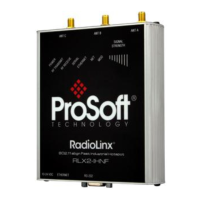Detailed Radio Configuration / Diagnostics RLX2 Series ♦ 802.11a, b, g, n
User Manual Industrial Hotspot
Page 84 of 161 ProSoft Technology, Inc.
May 8, 2013
6.4 Radio access settings
The following fields appear in the Security Settings area on the right side of the
Radio Configuration window.
In order to configure or diagnose a radio using its built-in Web server or SNMP
agent, both the computer and the radio must have IP addresses. These IP
addresses must be on the same subnet. An IP address is only needed to
configure the radio and view its diagnostic settings. Otherwise, the address is
unnecessary.
Allows the radio to obtain its IP address from a DHCP server.
Use the following IP
address
Specifies a Static IP address to the radio. Enter the IP address
information in the following fields.
Use an IP address that will not interfere with any other devices on the
network. Request a block of IP addresses to use from the Network
Administrator.
Subnet Mask provided by the Network Administrator.
Default Gateway address provided by the Network Administrator.
Primary DNS address provided by the Network Administrator.
Secondary DNS address provided by the Network Administrator.
Opens the SNMP (Simple Network Management Protocol) Agent
settings form. Use this form to configure access to radio network
settings through an SNMP agent.
Configures the Login Password for the radio. The default password is
"password". Change this password and keep a record of it in a safe
place, to protect the radio from being reconfigured by unauthorized
users.
DHCP (Dynamic Host Control Protocol) is a service provided by a server
(typically a router or a firewall) on a local area network. Devices on a network
that supports DHCP can request and receive an IP address from the DHCP
server. RLX2 radios support DHCP; by default, they attempt to obtain an IP
address from a DHCP server.
If a DHCP server is not available, the radio will not be able to acquire an IP
address automatically. Therefore, assign an IP address, subnet mask and
default gateway to the radio so that it can communicate on the network.

